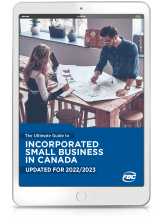Contents
- What is a non-capital loss?
- What are some examples of non-capital losses?
- For how many years can I carry back a non-capital loss?
- How many years can I carry forward a non-capital loss?
- What is an Allowable Business Investment Loss (ABIL)?
- When should I carry back a non-capital loss?
- How do I carry back a non-capital loss?
- When should I carry forward a non-capital loss?
- Where do I find my non-capital loss carryover amounts?
- [Free Download] Ultimate Guide to Incorporated Small Business in Canada
- Want to learn more?
Last updated: Feb. 7, 2025
What is a non-capital loss?
One of the realities of being a small business owner or farmer is that there are times when you will experience financial losses.
Losses occur for a variety of reasons, including economic downturns, poor investments, and unforeseen weather or climate events. When they do, it’s important to know how different types of losses impact your tax return.
The Canada Revenue Agency (CRA) classifies business losses as either capital losses or non-capital losses.
A capital loss occurs when you sell capital property for less than you paid for it. For example, if you buy 1,000 acres of farmland for $7,000 per acre but you sell it for $6,500 per acre, you have a capital loss of $500,000.
Generally, you can only deduct capital losses from capital gains, not employment income, but you can carry the losses back three years or keep them as a cushion for future capital gains.
You incur non-capital losses from non-capital sources (i.e., activities related to owning a small business, farm, or rental property). Common examples of non-capital losses are when your business or farming expenses are greater than your business income or your rental property doesn’t have a tenant for an extended period of time.
The CRA treats non-capital losses differently than capital losses. For example, while you can only deduct capital losses from capital gains, you can apply non-capital losses to income sources such as employment, registered retirement savings plan income, and interest amounts.
Get answers to some frequently asked questions about non-capital losses and take a closer look at their tax implications for farmers and small business owners.
What are some examples of non-capital losses?
There are a lot of situations that can cause a small business or farm to have more allowable expenses than income, resulting in non-capital losses.
Some specific examples include:
- Startup losses
- Business fluctuations
- Natural disasters
- Market fluctuations
- Unexpected expenses
- Economic downturns
- Operational inefficiencies
- Inventory write-offs
- Bad debts
For how many years can I carry back a non-capital loss?
Non-capital losses can be carried back up to three years to help recover previous taxes paid or carried forward 20 years to offset future tax liability. Different rules apply to an allowable business investment loss (ABIL), which we discuss in more detail later.
How many years can I carry forward a non-capital loss?
Depending on the taxation year, non-capital losses can be carried forward 7, 10, or 20 years and help reduce future taxable income and taxes payable.
The carry forward periods are:
- For taxation years ended March 22, 2004, or earlier: 7 years
- For taxation years ended after March 22, 2004: 10 years
- For taxation years ended after 2005: 20 years, except ABIL
What is an Allowable Business Investment Loss (ABIL)?
An ABIL is a special type of capital loss that you may claim if you experience a loss on an investment in a small business corporation or a small business corporation’s debt.
An ABIL is a capital loss arising from an arm’s-length disposition of shares of a small business corporation or debt owed to the taxpayer by a small business corporation.
Here are some key points you should know about ABIL:
- To claim an ABIL, you must have invested in shares or debt of a small business corporation. Generally, a corporation is considered “small” if it meets certain asset and income thresholds.
- The CRA considers an ABIL as a “capital loss.” They only allow a deduction of 50% of the ABIL from other income. This means that if you have an ABIL of $10,000, you can deduct $5,000 from your income for tax purposes.
- You can apply the ABIL against any source of income, not just capital gains. This provides some flexibility to offset other forms of income.
- You deduct an ABIL in the year it arises. Unused portions can be carried back 3 years and forward 10 years (for losses after 2003, as non-capital loss). If an ABIL remains unused after 10 years, it can then be treated as a capital loss and carried forward indefinitely as a deduction against taxable capital gains.
- There are some restrictions in the application of an ABIL including the requirement that the investment must be considered “completely worthless” to be considered an Allowable Business Investment Loss.
It’s important to note ABILs are very closely monitored by the CRA so always be prepared to back up your claim. Always consult with a qualified tax specialist to ensure you have the most accurate information and application of Allowable Business Investment Losses.
When should I carry back a non-capital loss?
There are times when it is advantageous to carry the non-capital loss back to previous years and recover taxes paid. Some things to consider:
- Did you pay a higher tax rate on your income than you are expecting to pay in the future?
- Are you expecting your business to show a reduced or lower profit in the coming years?
- Are you planning to sell your business soon?
- Do you want to carry the non-capital loss back to generate cash flow?
Whenever you plan to roll back a non-capital loss, you must do so within the year in which the loss occurred. If the loss remains unused in the year it happened, you can only carry the non-capital loss forward.
For example, if you incurred a loss in 2022 you must claim the rollback with your 2022 return. If you leave it unused in 2022, you will then only be able to carry it forward.
How do I carry back a non-capital loss?
If you are carrying back a non-capital loss to any of the last three years, you must complete Form T1A, Request for Loss Carryback, and include it with your Income Tax and Benefit Return. You can also send it separately.
For example, if you are filing your return for the 2022 tax year, you can use Form T1A to carry back losses back to 2019, 2020 or 2021.
Do not file an amended return for the year to which you want to apply the loss.
When should I carry forward a non-capital loss?
Carrying a non-capital loss forward to years where you believe you will pay a higher tax rate may help lower your overall tax payable.
Generally speaking, you can apply non-capital losses against any kind of income. If you expect large profits in the coming years, carrying the loss forward may help reduce your tax burden for those years.
Carrying a non-capital loss forward is optional. Different rules apply depending on the type of loss and the type of income you’re claiming the loss against. We recommend working with a tax specialist to ensure the non-capital loss carry forward will benefit your business.
Where do I find my non-capital loss carryover amounts?
If you have a CRA My Account, you can easily access your capital and non-capital loss carryover amounts under “Tax Returns”. Your Notice of Assessment will also have your available balances listed.
[Free Download] Ultimate Guide to Incorporated Small Business in Canada
Many incorporated business owners feel intimidated by the demands of tax season and the corporate filing requirements of the Canada Revenue Agency (CRA). This is completely natural.
While there are numerous benefits to incorporation, it also comes with complex obligations. The complexity and administrative burden of these requirements leave many businesses struggling to keep up.
That’s why we’ve created this guide – to help you make sense of your obligations under a corporate structure and to take advantage of the benefits!
Want to learn more?
Whether it’s determining how to use non-capital losses, tax preparation, tax planning, bookkeeping, payroll or financial planning, we’ve been helping farmers and small business owners save time and money through an integrated approach to their business and personal finances.
Leave your unique tax situation to us. We’ll get you every dollar you deserve. Book online or call us at 1-800-265-1002.




